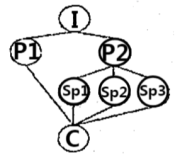1 . According to a new study, teens focus on rewards and have a hard time learning to avoid punishment or consider the consequences of alternative actions.
University College London researchers compared how teens and adults learn to make choices based on the available information. They tracked the way in which 18 volunteers aged 12-17 and 20 volunteers aged 18-32 completed tasks in which they had to choose between abstract symbols.
Each symbol was consistently associated with a fixed chance of a reward, punishment, or no outcome. As the trial progressed , participants learned which symbols were likely to lead to each outcome and adjusted their choices accordingly. Teens and adults were equally good at learning to choose symbols associated with reward, but teens were less good at avoiding symbols associated with punishment. Adults also performed significantly better when they were told what would have happened if they had chosen the other symbol after each choice, while teens did not appear to take this information into account.
“From this experimental lab study we can draw conclusions about learning during the teen years. We find that teens and adults learn in different ways, something that might be relevant to education," said lead author Dr. Stefano Palminteri. " Unlike adults, teens are not so good at learning to adjust their choices to avoid punishment. This suggests that incentive systems based on reward rather than punishment may be more effective for this age group. Additionally, we found that teens did not learn from being shown what would have happened if they made alternative choices."
To interpret the results, the researchers developed computational models of learning and ran simulations (模拟)applying them to the results of the study. The first was a simple model, one that learned from rewards, and the second model added to this by also learning from the option that was not chosen. The third model was the most complete and took the full context into account, with equal weight given to punishment avoidance and reward seeking. For example, obtaining no outcome rather than losing a point is weighted equally to gaining a point rather than having no outcome.
Comparing the experimental data to the models, the team found that teens" behavior followed the simple reward-based model while adults" behavior matched the complete, contextual model. “Our study suggests that teens are more receptive to rewards than they are to punishments of equal value, ” said senior author Dr. Sarah-Jayne Blakemore. “As a result, it may be useful for parents and teachers to frame things in more positive terms.”
1. It can be learned from the study that .| A.adults made choices faster than teens |
| B.adults understood rewards better than teens |
| C.teens reacted better to reward than punishment |
| D.teens were aware of the outcome of each choice |
| A.They reflected people’s strong desire for punishment avoidance. |
| B.They gave circumstances different degrees of consideration. |
| C.They paid equal attention to reward and punishment. |
| D.They shaped the behavior of people at different ages. |
| A.accustomed | B.opposed |
| C.sympathetic | D.responsive |
| A.“If you insist on doing things in this way, you will lose ten points. " |
| B.“If we had talked about this earlier, you wouldn’t have made the mistake. " |
| C.“ If you hand in your assignment ahead of time, you will get an extra bonus." |
| D.“If you want to approach a problem differently , you can talk to your parents. " |
2 . A Bridge Linking Art and the Audience
According to a 2018 report, people aged between 16 and 24 make up about 15 percent of the population but only 10 percent of museum-goers. Similarly, people aged over 35 go half as much as you would expect from their population size. We have reached the point of recognising the disconnection between art and the audience but haven’t yet determined how to bridge the gap. Two answers to tackling this challenge lie in telling a greater diversity of art histories and communicating these stories in more accessible ways.
In 2018, a radio program called Art Matters was started with the aim of discussing art from a pop-culture viewpoint with topics that would engage younger and more diverse audience. It offers an accessible pathway to art history with conversations on different topics. Art history is about storytelling; art content shines when there is an effort to bring audience along for the discussion.
More traditional institutions are paying attention. Recently the Getty Museum issued a social-media challenge for people to recreate paintings using items they had at home. Users displayed incredible creativity, and the museum was flooded with submissions. This reaction proves that there is a potential desire for the audience to engage with art topics if the format is appealing. Since many people feel intimidated and think that there’s a base level of understanding required to join the conversation, the Getty initiative serves as a reminder that there are many pathways to engaging with it.
Another result of the Getty challenge was the exposure given to a diversity of artworks. The famous opera singer Peter Brathwaite, for example, made scores of attractive recreations highlighting centuries of black paintings. His efforts opposed the idea that there were not many historical paintings of black figures. It is extremely important that we do a better job of showing the complex and diverse stories that are represented in art.
Social media have offered a platform for people who have not traditionally had a seat at the table. Anyone can recognise a gap in the field and address it. Accounts have gathered tens of thousands of followers. They are the proof that there is hunger to hear these art histories, and these themes work brilliantly for museum programming.
But there is only so much that can be done without the museums and galleries changing meaningfully from within. We need to see a better balance of these stories represented in permanent collections. We also need a much wider diversity of people and interests represented on board. Ensuring that art-and writing and talking about art-is able to continue on the rising generation of storytellers, inside and outside of institutions, getting the funding and support they need to paint a brighter picture for the part.
1. What challenge is the author trying to tackle?| A.People doubt a great diversity of artworks. |
| B.Fewer and fewer young people go to museums. |
| C.Art appears too distant from common audience. |
| D.Adult audience has a different understanding of art. |
| A.Tired. | B.Worried. | C.Annoyed. | D.Surprised. |
| A.make the art history stories accessible in a traditional way. |
| B.change meaningfully for activities like the Getty challenge. |
| C.limit the number of storytellers both in and out of institutions. |
| D.improve the permanent collections by adding famous artworks. |
| A.lacks the channels to understand and talk about art history. |
| B.prefers to view artworks and hear art stories on social media. |
| C.feels satisfied with people and interests represented on board. |
| D.refuses to engage with diverse art topics and art history stories. |
3 . The Land Under the Sea
Ten thousand years ago, as the last ice age ended, sea levels around the world were far lower than they are today. Much of the land under both the North Sea to the east of Britain and the English Channel which now separates France and Britain was part of a huge region of forests and grassy plains. Then the climate gradually became warmer and the water trapped in large masses of ice was released.
Now the development of advanced sonar (声呐) technology, known as bathymetry, is making it possible to study this flooded landscape in extraordinary detail. A special echo (回声) sounder is fixed to the bottom of a survey ship and it makes wide sweeps across the seabed. While previous technology has only been able to produce two-dimensional images, bathymetry can now use computers, satellite-positioning equipment and special software to create accurate and remarkably detailed maps. For the first time, an ancient riverbed jumps out of the three-dimensional image. The site of pre-historic settlements can now be pinpointed.
According to expert Linda Andrews, this technological development is of huge significance. “We now have the ability to map the seabed as accurately as we can map dry land,” she says.
Once bathymetric techniques have identified sites where people might have built their homes and villages, divers can be sent down to investigate further. Robot submarines (潜艇) can also be used, and researchers hope they will find stone tools and wood from houses as proof of human activity. The idea shared by many people in Britain of their country as a natural island kingdom will be challenged by the findings: Britain has been inhabited for about 500,000 years and much of this time it has been linked on and off to continental Europe. It remains to be seen how far this new awareness is taken on board, however.
In fact, the use of bathymetry will not be limited to the study of lost landscapes and ancient settlements. It will also be vital in finding ships that have been destroyed in accidents. In addition, commercial applications are a real possibility. Aggregates (骨材) for the construction industry are becoming increasingly expensive, and bathymetry can be used to identify suitable sites for digging for this material. Mapping the seabed will also identify places where rare plants and shellfish are living. Digging at such sites should be prevented, either to work for a profit or to make deeper waterways for massive container ships.
1. How does bathymetry work?| A.It has an echo sounder placed on the seabed. |
| B.It makes use of a number of different devices. |
| C.It produces two-dimensional images of the sea floor. |
| D.It bases its calculations on the location of construction sites. |
| A.Occupied. | B.Adjusted. |
| C.Rebuilt. | D.Discovered. |
| A.attract investment in the research under the sea |
| B.inspire people to take an interest in modern technology |
| C.adapt the attitudes of the British to their country’s history |
| D.receive confirmation of rebuilding ancient man-made objects |
| A.identify new species of plants and animals |
| B.provide the precise location of sunken ships |
| C.evaluate the cost of seeking certain resources |
| D.promote the development of deeper waterways |
4 . Social Networking Sites: Are They Changing Human Communication?
It is hardly news that people are using the Internet to communicate with others more and more. Some people fear that someday we will no longer feel the need to talk to one another face to face. However, some recent studies suggest that people communicate, or stay in touch, even more than they used to. Whichever side you fall on, what is clear and without a doubt is that human communication has changed in the 21st century. But results of recent scientific studies may have us reconsider just how much our new communication forms have changed our world.
In June 2008, a British psychiatrist, Himanshu Tyagi, warned that communicating on social networking sites could have a negative effect on the generation of people born after 1990. This generation has never known a world without the Internet. Tyagi says that these people use the Internet to communicate with others so much that they may have trouble forming real relationships. Tyagi is concerned that people may start and end relationships over the Internet. Describing the Internet he said, “It’s a world where everything moves fast and changes all the time, where relationships are quickly ended at the click of a mouse.”
Another psychologist, Dr. Aric Sigman, warned of the physical effects that come with using social networking sites. He suggests that the reduction in the amount of time we spend interacting (互动交流) with people face to face could have biological effects on the human body. The results of his study suggest that, without real personal interaction, the body does not react the same way it would if people were meeting face to face. As a result, immune responses, even hormone levels, can be changed. These changes may lead to the development of illnesses, such as cancer.
Despite these warnings, studies can be found that show the positive sides of social networking sites. The results of one study show that using social networking sites has increased the self-esteem (自尊心) of young adults. Another suggests that college students using these sites feel more “connected” with people when they use them. In addition to scientific studies, there are many who feel that the benefits of social networking sites outweigh the possible negative sides. Many people, especially those who spend a lot of time at home, for various reasons, find the Internet a lifeline. They are able to communicate with many people using these sites.
Perhaps the key to this new communication style is self-control and common sense. If someone spends all of his time on the Internet, and never actually sees friends face to face, that seems like an unhealthy way to live. But if someone spends time on the Internet, some of which is spent arranging meetings for “real” time together, then it seems almost complementary (互补的). Balance is the key to keeping communication alive and well in the 21st century.
1. Which of the following ideas may Himanshu Tyagi agree with?| A.Social networking sites harm people of all ages. |
| B.The Internet weakens young people’s relationships. |
| C.The use of the Internet improves people’s immune system. |
| D.The online world pushes people to live a faster and better life. |
| A.It will stop the face-to-face interaction. |
| B.It reduces the self-esteem of young adults. |
| C.It may cause some serious health problems. |
| D.It makes people feel less connected with others. |
| A.Are greater than. | B.Are heavier than. |
| C.Are more effective than. | D.Are more difficult than. |
CP: Central Point P: Point Sp: Sub-point(次要点) C: Conclusion
A. | B. |
C. | D. |
5 . Seeds on Ice

Close to the North Pole,remote and rocky Plateau Mountain in the Norwegian archipelago of
Svalbard seems an unlikely spot for any global effort to safeguard agriculture. In this cold and deserted environment,no grains,no gardens,no trees can grow. Yet at the end of a 130-meter-long tunnel cut out of solid stone is a room filled with humanity’s most precious treasure, the largest and most diverse seed collection—more than a half-billion seeds.
A quiet rescue mission is under way. With growing evidence that unchecked climate change-will seriously affect food production and threaten the diversity (多样性) of crops around the world,the Svalbard Global Seed Vault (地窖) represents a major step towards ensuring the preservation (贮藏) of hundreds of thousands of crop varieties. This is a seed collection, but more importantly, it is a collection of the traits found within the seeds:the genes that give one variety resistance to a particular pest and another variety tolerance for hot,dry weather.
Few people will ever see or come into contact with the contents of this vault. In sealed boxes,behind multiple locked doors,monitored by electronic security systems, enveloped in below—zero temperatures, and surrounded by tons of rock, hundreds of millions of seeds are protected in their mountain fortress. Frozen in such conditions inside the mountain, seeds of most major crops will remain viable for hundreds of years, or longer. Seeds of some are capable of retaining (保留) their ability to grow for thousands of years.
Everyone can look back now and say that the Seed Vault was a good and obvious idea, and that of course the Norwegian government should have approved and funded it. But back in 2004, when the Seed Vault was proposed, it was viewed as a crazy,impractical, and expensive idea.
We knew that nothing would provide a definite guarantee. But we were tired,fed up,and frankly scared of the steady, greater losses of crop diversity. The Seed Vault was built by optimists who wanted to do something to preserve options so that humanity and its crops might be better prepared for change. If it simply resupplied seed gene banks with samples those gene banks had lost, this would repay our efforts.
The Seed Vault is about hope and commitrnent - about what can be done if countries come together and work cooperatively to accomplish something significant,long-lasting,and worthy of who we are and wish to be.
1. According to the passage, the Seed Vault is ___________.| A.a tunnel where the collected seeds are displayed |
| B.a stone room that contains the seeds of endangered crops |
| C.a seed gene bank that stores diverse seeds for future agriculture |
| D.a lab where researchers study how to maintain the diversity of crops |
| A.mature | B.clean |
| C.alive | D.valuable |
| A.how the seeds are preserved | B.where people keep the seeds |
| C.why the seeds are protected | D.what people do to study the seeds |
| A.the Seed Vault offers a solution to climate change |
| B.most countries took part in rescuing the seed varieties |
| C.the Seed Vault guarantees to prevent the loss of crop diversity |
| D.many people originally considered building the Seed Vault unwise |
6 . In the mid-2000s, Waze Mobile co-founder Ehud Shabtai received a cutting-edge (尖端的) gift from girlfriend: a GPS. The expensive gift was supposed to be helpful. But straight out of the box, it was already out of date.
Shabtai, a coding enthusiast, had an immediate reaction to reinvent. Shabtai’s solution? To build an app. With 80 million monthly active users globally and nearly 400,000 superusers who function much like Wikipedia volunteer editors (editing maps rather than words), Waze Mobile caught the eye of Google as a revolutionary approach to navigation (导航).
Acquired by Google in 2013, Waze’s value mainly lies in its high rate of user involvement. Unlike traditional navigation apps that simply show directions, Waze asks its users to report accidents and other road conditions in real time, so other users can avoid the traffic by using an alternative route.
The goal behind Waze’s approach is an ambitious one: not just avoid traffic, but end it altogether. Waze is finding new ways to put its loyal and active user base to use to make that vision a reality, including a plan to make carpooling (拼车) cool.
To be sure, traffic jams are troubling people all over the world. Waze has been quietly ahead of the game for some time. In 2013, when Waze was just a small digital-mapping business with limited resources it had something Google Maps and other competitors didn’t: richer GPS guidance thanks to its stream of live traffic reports from users.
These users were the basis of Shabtai’s plan to solve for his GPS device’s “silent” hardware: he grounded the app in software that could be perpetually updated by users, anywhere and anytime.
Waze Carpool is going straight to the heart of traffic jams, trying to get more drivers off the road and into carpools. The app has already connected tens of thousands of rideseekers with drivers willing to ferry them along a shared route, and that trend could be the answer to a traffic-free future.
1. What did Shabtai do when he found his girlfriend’s gift out of date?| A.He improved it. | B.He took it apart. |
| C.He put it away. | D.He used it anyway. |
| A.It has the most users. | B.It can indicate directions. |
| C.It reports road conditions in real time. | D.Most users help edit its words. |
| A.Difficultly. | B.Carefully. |
| C.Greatly. | D.Constantly. |
| A.The rise of carpooling. | B.An advanced navigation app. |
| C.The development of Google. | D.Traffic problems in the world. |
But have you ever notice the smell? Unless it is bad, the answer is likely to be no. But while a shop’s scent may not be outstanding compared with sights and sounds, it is certainly there. And it is providing to be an increasing powerful tool in encouraging people to purchase.
A brand store has become famous for its distinctive scent which floats through the fairly dark hall and out to the entrance, via scent machines. A smell may be attractive but it may not just be used for freshening air. One sports goods company once reported that when it first introduced scent into its stores, customers’ intension to purchase increased by 80 percent.
When it comes to the best shopping streets in Pairs, scent is just as important to a brand’s success as the quality of its window displays and goods on sales. That is mainly because shopping is a very different experience to what it used to be.
Some years ago, the focus for brand name shopping was on a few people with sales assistants’ disproving attitude and don’t-touch-what-you-can’t-afford displays. Now the rise of electronic commerce (e-commerce) has opened up famous brands to a wider audience. But while e-shops can use sights and sounds, only bricks-and-mortar stores (实体店) can offer a full experience from the minute customers step through the door to the moment they leave. Another brand store seeks to be much more than a shop, but rather a destination. And scent is just one way to achieve this.
Now a famous store uses complex man-made smell to make sure that the soft scent of baby powder floats through the kid department, and coconut (椰子) scent in the swimsuit section. A department store has even opened a new lab, inviting customers on a journey into the store’s windows to smell books, pots and drawers, in search of their perfect scent.
1. According to the passage, what is an increasingly powerful tool in the success of some brand store?
| A.Friendly assistant. | B.Unique scents. |
| C.Soft background music. | D.Attractive window display. |
| A.show the advantages of brick-and-mortar stores |
| B.urge shop assistants to change their attitude |
| C.push stores to use sights and sounds |
| D.introduce the rise of e-commerce |
| A.a platform that exhibits goods |
| B.a spot where travelers like to stay |
| C.a place where customers love to go |
| D.a target that a store expects to meet |
| A.compare and evaluate | B.examine and assess |
| C.argue and discuss | D.inform and explain |
8 . Something’s happening at the lowest point on our planet,some 1,388 feet below sea level. The Dead Sea, a salt lake close to Israel, Jordan and the West Bank, is shrinking at an alarming rate—about 3.3 feet per year, according to the environmentalist group EcoPeace Middle East.
“It’s not just like one country is punishing the Dead Sea; it’s more like the whole region,” said photographer Moritz Küstner, who visited the area in February to work on his series “The Dying Dead Sea”.
The Dead Sea needs water from the other natural sources surrounding it, such as the Jordan River basin. But around the 1960s, the courses of some water sources it relied upon were diverted. Israel, for instance, built a pipeline during that time so it could supply water throughout the country.
Mineral extraction(提取) industries are another main reason why the water levels are declining, experts say. The Dead Sea’s minerals have been popular for their medical power and can often be found in cosmetics(化妆品) and other consumer products.
And then, of course, there’s the Middle East’s hot, dry climate, which makes it difficult for the lake to refill itself. Last year, Israel and Jordan signed a $900 million deal in an effort to stabilize the Dead Sea’s water levels. It involves building a canal from the Red Sea to the Dead Sea which would be able to not only supply water to Israel and Jordan but also to pump much needed water—some 300 million cubic meters annually—into the Dead Sea.
“This is the most important and significant agreement since the peace treaty with Jordan (in 1994),” said Silvan Shalom, Israel’s energy and water resources minister at the time. Whether the canal—estimated to take three years to complete—will work out positively and as planned remains to be seen.
For now, Küstner shows us that the Dead Sea remains very much a place of interest, with people from all over the world going there to swim in its salty waters.
1. How many reasons for the Dead Sea’s shrinking does the author mention in the passage?| A.One. | B.Two. |
| C.Three. | D.Four. |
| A.Switch. | B.Improve. |
| C.Accomplish. | D.Repair. |
| A.The Dead Sea is drying out causing water shortage to humans. |
| B.Küstner visited the Dead Sea to shoot TV series about people’s life. |
| C.The Dead Sea’s minerals have been used in some products. |
| D.The Dead Sea’s water levels have been stabilized by building a canal. |
| A.How the Dead Sea’s water levels’ decline influences human beings. |
| B.How important the Dead Sea is in Israel,Jordan and the West Bank. |
| C.What we should do to save the Dead Sea from being destroyed. |
| D.Why the Dead Sea is dying and the measure taken to save it. |
9 . What a Messy Desk Says About You
For some time, psychologists have been studying how personality traits affect health and health-related choices. Not surprisingly, they have found that people blessed with innate conscientiousness, meaning that they are organized and predictable, typically eat better and live longer than people who are disorderly. They also tend to have immaculate offices.
What has been less clear is whether neat environments can produce good habits even in those who aren’t necessarily innately conscientious. To find out, researchers at the University of Minnesota conducted a series of experiments. In the first experiment, they randomly assigned a group of college-age students to spend time in two office spaces, one of which was very neat, the other wildly cluttered (乱堆) with papers and other work-related stuff. The students spent their time filling out questionnaires unrelated to the study. After 10 minutes, they were told they could leave with an apple or a chocolate bar. Those students who sat in the orderly office were twice as likely to choose the apple as those who sat among the mess.
A second experiment, however, found that working in chaos has its advantages, too. In this one, college students were placed in a messy or a neat office and asked to dream up new uses for Ping-Pong balls. Those in messy spaces generated ideas that were significantly more creative, according to two independent judges, than those in offices where stacks of papers and other objects were neatly arranged.
The results were something of a surprise, says Dr. Vohs, the leader of the study. Few previous studies found much virtue in disorder. The broken window theory, proposed decades ago, holds that even slight disorder and neglect can encourage indifference and poor discipline.
But in the study by Dr. Vohs, disordered offices encouraged originality and a search for novelty. In the final portion of the study, adults were given the choice of adding a health “boost” to their lunchtime smoothie that was labeled either “new” or “classic.” The volunteers in the messy space were far more likely to choose the new one; those in the tidy office generally chose the classic version. “Disorderly environments seem to inspire breaking free of tradition,” Dr. Vohs and her co-authors conclude in the study, “which can produce fresh insights.”
The implications of these findings are also practical. “My advice would be, if you need to think outside the box for a future project”, Dr. Vohs says, “then let the clutter rise and free your imagination. But if your primary goal is to eat well or to go to the gym, pick up around your office first. By doing this, the naturally messy can acquire some of the discipline of the conscientious.”
1. The underlined word “immaculate” in paragraph 1 probably means ______.| A.messy | B.tidy |
| C.terrible | D.comfortable |
| A.Chaos begets chaos. | B.Misfortune may be an actual blessing. |
| C.Bad news has wings. | D.When a door shuts, a window opens. |
| A.More virtue exists in organized people. |
| B.Creativity results from tidiness and discipline. |
| C.Disorderly surroundings help to create new ideas. |
| D.Workers’ good habits guarantee the success of a project. |
| A.The naturally neat people tend to be very creative. |
| B.A messy office will cause quite low working efficiency. |
| C.Environments can affect people’s way of thinking and behavior. |
| D.People’s personalities are determined by their working environments. |
10 . Ownership used to be about as straightforward as writing a cheque. If you bought something, you owned it. If it broke, you fixed it. If you no longer wanted it, you sold it or threw it away. In the digital age, however, ownership has become more slippery. Since the coming of smartphones, consumers have been forced to accept that they do not control the software in their devices; they are only licensed to use it. As a digital chain is wrapped ever more tightly around more devices, such as cars and thermostats, who owns and who controls which objects is becoming a problem. Buyers should be aware that some of their most basic property rights are under threat.
The trend is not always harmful. Manufacturers seeking to restrict what owners do with increasingly complex technology have good reasons to protect their copyright, ensure that their machines do not break down, support environmental standards and prevent hacking. Sometimes companies use their control over a product's software for the owners' benefit. When Hurricane Irma hit Florida this month, Tesla remotely updated the software controlling the batteries of some models to give owners more range to escape the storm.
But the more digital strings are attached to goods, the more the balance of control leans towards producers and away from owners. That can be inconvenient. Picking a car is hard enough, but harder still if you have to dig up the instructions that tell you how use is limited and what data you must give. If the products are intentionally designed not to last long, it can also be expensive. Already, items from smartphones to washing machines have become extremely hard to fix, meaning that they are thrown away instead of being repaired.
Privacy is also at risk. Users become terrified when iRobot, a robotic vacuum cleaner, not only cleans the floor but also creates a digital map of the inside of a home that can then be sold to advertisers (though the manufacturer says it has no intention of doing so). Cases like this should remind people how jealously they ought to protect their property rights and control who uses the data that is collected.
Ownership is not about to go away, but its meaning is changing. This requires careful inspection. Devices, by and large, are sold on the basis that they enable people to do what they want. To the extent they are controlled by somebody else, that freedom is compromised.
1. What benefit does it bring to customers if companies control the ownership of products?| A.It provides them with knowledge to prevent hacking. |
| B.It gives them the chance to be protected from danger. |
| C.It enables them to own the copyright of the products. |
| D.It helps them know more about complex technology. |
| A.control other people | B.share the ownership |
| C.inspect devices at any time | D.use devices as one wishes |
| A.customers should buy fewer digital devices |
| B.producers should control property rights |
| C.property rights need to be protected |
| D.better after sales service is required |
I: Introduction P: Point Sp: Sub-point (次要点) C: Conclusion
A. | B. |
C. | D. |



